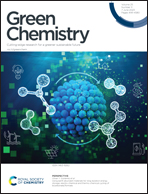Environmental, cost, and chemical hazards of using alternative green solvents for fullerene (C60) purification†
Abstract
C60 is a nanomaterial produced from the pyrolysis of hydrocarbons that needs to be extracted and purified to obtain the desired properties. Previous studies reported purification as the environmental hotspot of the C60 production process. However, no study has evaluated existing C60 purification methods and proposed alternatives based on environmental, cost, and chemical hazards. Here we used life cycle assessment (LCA) and evaluated the most common existing C60 purification methods (chromatography-crystallization, crystallization, & complexation) and identified selective complexation with 1,8-diazabicyclo[5.4.0]undec-7-ene (DBU) as the greenest existing C60 purification technique that has less environmental (70% from chromatography-crystallization & 50% from crystallization), cost (70% from chromatography-crystallization & 80% from crystallization), and chemical (30% from chromatography-crystallization & crystallization) hazards. The solvent (1,2,4-trymethylbenzene (TMB)) was identified as the environmental hotspot contributing to more than 95% of the cumulative energy demand (CED) of the complexation process. We employed green chemistry principles and an iterative approach to assess the performance of potential replacements (linseed oil, olive oil, toluene, & xylene) for TMB. Although we evaluated solvents that are expected to be greener than petroleum-based solvents, we determined toluene as the greenest alternative. Compared to the baseline complexation method, using toluene reduced the environmental impact by 59%, cost by 85%, and chemical hazards by 42%. Identifying toluene as the alternative green solvent for C60 purification can reduce the carbon footprint of C60-containing products used for various emerging applications, such as solar cells, hydrogen storage, biofuels, etc., which aligns with current decarbonization strategies.



 Please wait while we load your content...
Please wait while we load your content...